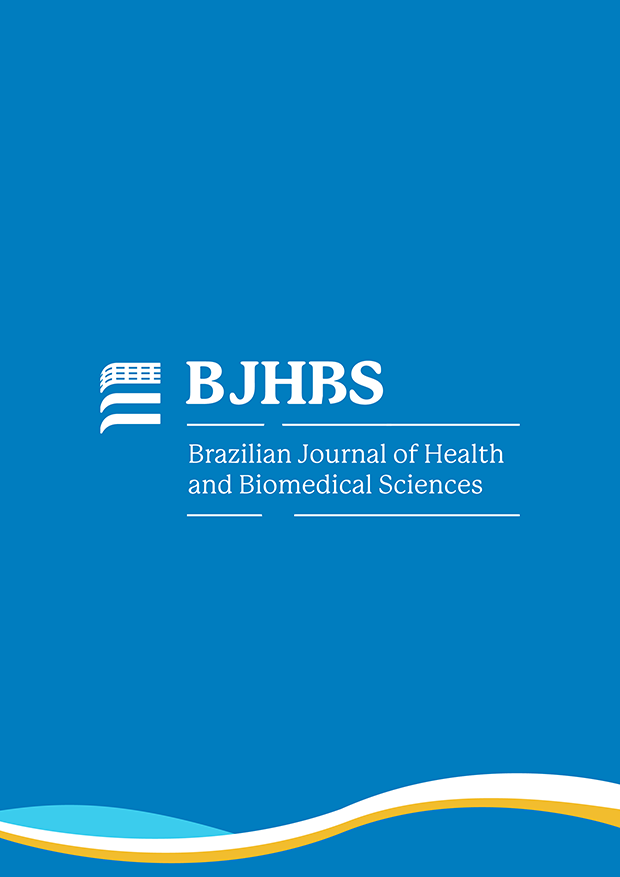Published 2022-01-04
Keywords
- COVID-19,
- SARS-CoV-2,
- Smoking,
- Risk factor
How to Cite
Copyright (c) 2021 Brazilian Journal of Health and Biomedical Sciences

This work is licensed under a Creative Commons Attribution-NonCommercial-NoDerivatives 4.0 International License.
Abstract
Introduction: Due to the COVID-19 pandemic, it is ex-tremely important to determine the risk factors that define patients who are more susceptible to the severe form of the disease; however, the observation of supposedly pro-tective factors is also of great relevance. Smoking has been the subject of controversy as to whether it is a protective factor or a risk factor for COVID-19. Objective: To assess how smokers behave within the context of the COVID-19 pandemic. Patients and methods: The participants in this study were a spontaneously recruited sample from the Rio de Janeiro State University COVID-19 Reference Centre, between March and May 2020. All patients underwent clinical, laboratory, and nasal swabs for the Sars-Cov-2 PCR investigation. Whenever it was the necessary case, patients were referred to hospitalization. Results: A total of 4,636 patients with suggestive symptoms of COVID were evalu-ated. There was 230 (4.9%) smokers in this group; there is a 10.3% smoking prevalence in the state of Rio de Janeiro as described in 2018. A number of 2,246 patients (48.6% of the total sample) were diagnosed with COVID-19, only 82 of these (3.7% of the total positive COVID) were smokers. Only 1 (0.01%) of the smokers with COVID-19 needed hospitalization. As far as the assessed symptoms, smokers showed fewer symptoms during the disease. Conclusion: The study suggests that smokers have fewer symptoms (mild or asymptomatic symptoms) and that there is a need to expand specific testing for that group.
Metrics
References
- Guan WJ, Ni ZY, Hu Y, et al. Clinical Characteristics of Coronavirus Disease 2019 in China. N Engl J Med. 2020;382(18):1708-1720. doi:10.1056/NEJMoa2002032
- Pascarella G, Strumia A, Piliego C, et al. COVID-19 diagnosis and management: a comprehensive review. J Intern Med. 2020;288(2):192-206. doi:10.1111/joim.13091
- Hu Y, Sun J, Dai Z, et al. Prevalence and severity of corona virus disease 2019 (COVID-19): A systematic review and meta-analysis. J Clin Virol. 2020;127:104371. doi:10.1016/j. jcv.2020.104371
- Singhal T. A Review of Coronavirus Disease-2019 (COVID-19). Indian J Pediatr. 2020;87(4):281-286. doi:10.1007/s12098-020-03263-6
- Harapan H, Itoh N, Yufika A, et al. Coronavirus disease 2019 (COVID-19): A literature review. J Infect Public Health. 2020;13(5):667-673. doi:10.1016/j.jiph.2020.03.019
- Brake SJ, Barnsley K, Lu W, et al. Smoking Upregulates Angiotensin-Converting Enzyme-2 Receptor: A Potential Adhesion Site for Novel Coronavirus SARS-CoV-2 (Covid-19). J Clin Med. 2020;9(3):841. doi:10.3390/jcm9030841
- Miyara M, Tubach F, Pourcher V, et al. Low incidence of daily active tobacco smoking in patients with symptomatic COVID-19. Qeios. 2020. https://doi.org/10.32388/WPP19W.3
- Jha P, Ramasundarahettige C, Landsman V, et al. 21st-century hazards of smoking and benefits of cessation in the United States. N Engl J Med. 2013;368(4):341-350. doi:10.1056/NEJMsa1211128
- Tsigaris P, Teixeira da Silva JA. Smoking Prevalence and COVID-19 in Europe. Nicotine Tob Res. 2020;22(9):1646-1649. doi:10.1093/ntr/ntaa12
- Vardavas CI, Nikitara K. COVID-19 and smoking: A systematic review of the evidence. Tob Induc Dis. 2020;18:20. doi:10.18332/tid/119324
- Cai G, Bossé Y, Xiao F, et al. Tobacco Smoking Increases the Lung Gene Expression of ACE2, the Receptor of SARS-CoV-2. Am J Respir Crit Care Med. 2020;201(12):1557-1559. doi:10.1164/rccm.202003-0693LE
- Leung JM, Niikura M, Yang CWT, et al. COVID-19 and COPD. Eur Respir J. 2020;56(2):2002108. doi:10.1183/13993003.02108-2020.
- World Health Organization. Smoking and COVID-19. Scientif Brief World Health Organization [cited 2020 May 26] Available from: https://apps.who.int/iris/bitstream/handle/10665/332182/WHO-2019-nCoV-Sci_Brief-Smoking-2020.1-eng.pdf
- Emami A, Javanmardi F, Pirbonyeh N, et al. Prevalence of Underlying Diseases in Hospitalized Patients with COVID-19: a Systematic Review and Meta-Analysis. Arch Acad Emerg Med. 2020;8(1):e35.
- Farsalinos K, Barbouni A, Niaura R. Systematic review of the prevalence of current smoking among hospitalized COVID19 patients in China: could nicotine be a therapeutic option?Internal and Emergency Medicine. 2020. May 9;1-8. https://doi:10.1007/s11739-020-02355-7
- Zheng Z, Peng F, Xu B, et al. Risk factors of critical & mortal COVID-19 cases: A systematic literature review and meta-analysis. J Infect. 2020;81(2):e16-e25. doi:10.1016/j. jinf.2020.04.021
- Guo FR. Active smoking is associated with severity of coronavirus disease 2019 (COVID-19): An update of a meta-analysis. Tob Induc Dis. 2020;18:37. doi:10.18332/tid/121915
- Zhao Q, Meng M, Kumar R, et al. The impact of COPD and smoking history on the severity of COVID-19: A systemic review and meta-analysis. J Med Virol. 2020;10.1002/jmv.25889. doi:10.1002/jmv.25889
- Le Bert N, Tan AT, Kunasegaran K, et al. SARS-CoV-2-specific T cell immunity in cases of COVID-19 and SARS, and uninfected controls. Nature. 2020;584(7821):457-462. doi:10.1038/s41586-020-2550-z





